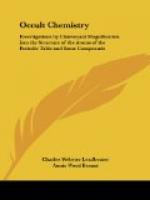therein instead of one hundred and twenty-eight. Tin, to make room for the
necessary increase of atoms, adopts the system of spikes, which we met with
in zinc (see Plate IX, 2); these spikes, like the funnels, radiate from the
central globe, but are only six in number. The twenty-one-atomed cone at
the head of the spike we have already seen in silver, and we shall again
find it in iridium and platinum; the pillars are new in detail though not
in principle, the contained globes yielding a series of a triplet, quintet,
sextet, septet, sextet, quintet, triplet.
TIN: 8 funnels of 156 atoms 1248
6 spikes of 126 "
756
Central globe
120
——
Total
2124
——
Atomic weight
118.10
Number weight 2124/18
118.00
V.—THE BARS GROUPS.
[Illustration: PLATE XVII.]
Here, for the first time, we find ourselves a little at issue with the accepted system of chemistry. Fluorine stands at the head of a group—called the inter-periodic—whereof the remaining members are (see Crookes’ table, p. 28), manganese, iron, cobalt, nickel; ruthenium, rhodium, palladium; osmium, iridium, platinum. If we take all these as group V, we find that fluorine and manganese are violently forced into company with which they have hardly any points of relationship, and that they intrude into an otherwise very harmonious group of closely similar composition. Moreover, manganese reproduces the characteristic lithium “spike” and not the bars of those into whose company it is thrust, and it is thus allied with lithium, with which indeed it is almost identical. But lithium is placed by Crookes at the head of a group, the other members of which are potassium, rubidium and caesium (the last not examined). Following these identities of composition, I think it is better to remove manganese and fluorine from their incongruous companions and place them with lithium and its allies as V a, the Spike Groups, marking, by the identity of number, similarities of arrangement which exist, and by the separation the differences of composition. It is worth while noting what Sir William Crookes, in his “Genesis of the Elements,” remarks on the relations of the interperiodic group with its neighbours. He says: “These bodies are interperiodic because their atomic weights exclude them from the small periods into which the other elements fall, and because their chemical relations with some members of the neighbouring groups show that they are probably interperiodic in the sense of being in transition stages.”
Group V in every case shows fourteen bars radiating from a centre as shown in iron, Plate IV, 1. While the form remains unchanged throughout, the increase of weight is gained by adding to the number of atoms contained in a bar. The group is made up, not of single chemical elements, as in all other cases, but of sub-groups, each containing three elements, and the relations within each sub-group are very close; moreover the weights only differ by two atoms per bar, making a weight difference of twenty-eight in the whole. Thus we have per bar:—




